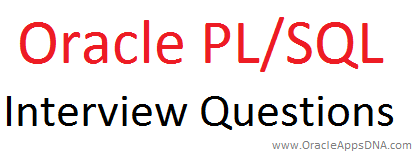
Click on the question to see the answer
Basic PL/SQL Interview Questions
- Difference between Syntax and Runtime errors in PL/SQL??
- Explain what is COMMIT, ROLLBACK and SAVEPOINT??
- How many types of Triggers are there in PL/SQL and what are they?
- How to generate Debugging Information in PL/SQL?
- In what order should a open/fetch/loop set of commands in a PL/SQL block be implemented?
- Name any 5 PL/SQL exception types
- What are the two different types of Exceptions in PL/SQL?
- What is IN parameter and OUT parameter in PLSQL?
- What is Public and Private Procedures in PL/SQL?
- What is Referential Integrity?
- What is SQLCODE and SQLERRM in PL/SQL?
- What is the difference between CASE and DECODE?
- What is the difference between VARCHAR and VARCHAR2 in PL/SQL?
- What is %TYPE and %ROWTYPE in PL/SQL??
- What is the disadvantage of using %ROWTYPE in PL/SQL?
- What are the advantages of using %TYPE and $ROWTYPE in PL/SQL?
- List all different types of Data Types in PL/SQL?
- What is the difference between Views and Materialized Views in Oracle?
- What is difference between a PROCEDURE & a FUNCTION ?
- What are the Advantages of Using Database Triggers??
- What are two virtual tables available during database trigger execution in PL/SQL?
- Is it mandatory to close the Cursor in a PL/SQL block ?
- What is difference between % ROWTYPE and TYPE RECORD?
- How does an Explicit Cursor work in PL/SQL?
- Can we use RETURN STATEMENT and RETURN key word in Procedure, if we use what will happen?
- How to debug your PL/SQL procedure?
Click on the question to see the answer
Advanced PL/SQL Interview Questions
-
- Does SQL*PLUS has embedded PLSQL engine?
- How does an Implicit Cursor work in PL/SQL?
- How does ROWID help in running a query faster?
- How to return more than one value from a Function in PL/SQL
- How to use COMMIT in PL/SQL Trigger?
- In a PL/SQL block of code how do you find if a Cursor is STILL open?
- What are all the special operators does Oracle provide for dealing with NULLs?
- What are Explicit Cursor attributes and what are they?
- What are Implicit Cursor attributes and what are they?
- What are the rules to be applied to NULL while doing comparison in an expression?
- What is a trigger and what is the difference between Row Level and Statement Level trigger??
- What is Autonomous transaction in PL/SQL?
- What is Global Temporary Tables and What is it Purpose?
- What is Mutating error in PL/SQL Triggers?
- What is RAISE_APPLICATION_ERROR is PL/SQL?
- What is SYS_GUID() function? and what is the purpose of SYS_GUID function?
- What is the maximum number of triggers, can apply to a single table?
- What steps are included in the compilation process of a PL/SQL block?
- How to avoid usage of Cursors in PL/SQL?
- How to return more than one value from a Function in PL/SQL
- How is the Cursor declared in Procedure is different from Cursor defined in Package Specification?
- What is RAISE_APPLICATION_ERROR in PL/SQL Exception handling??
- What is PRAGMA EXECPTION_INIT?
- What happens if a procedure which updates a column of table X is called in a database trigger of the same table?
- What is the purpose of WHERE CURRENT OF statement in PL/SQL?
- Why cant we use SQLERRM and SQLCODE in INSERT Statement?
- Can we write When OTHERS Exception at the beginning of the exception block and some other exceptions after that ?
- What is Cursor Variables or REF CURSOR ?
- What are the Disadvantages of Cursor Variables?
- What are the advantages of using %TYPE and $ROWTYPE in PL/SQL?
- How to find Package/Procedure name and Line Number where the program got errored out???
- What is BULK COLLECT in PL/SQL?
Note: New Questions will be added to this list on regular basis